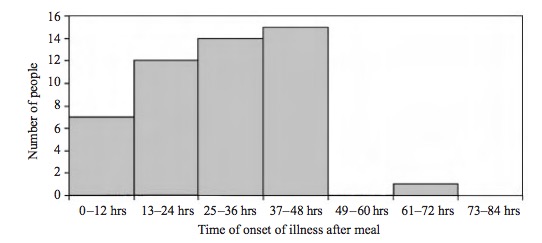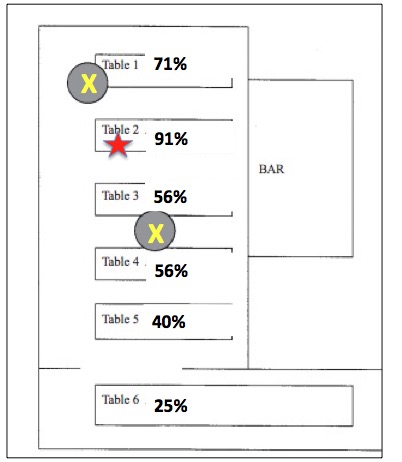
How would you like to be an unwilling participant of the world's first and only clinical trial that studied the transmission of the hideous norovirus (aka "stomach flu") as a function of distance? I'm guessing probably not. It is not too big a leap of faith to assume that the people in a Derby, U.K. hotel restaurant in 1998 would have cheerfully opted out of this experiment. Nonetheless, it was conducted at their own expense.
But, the "experiment," which was published in the journal Epidemiology and Infection did contribute to the body of knowledge of another way that norovirus, which is thought to be the most contagious pathogen on earth, (1) spreads—by air. As if we need another way to catch it? Especially in a restaurant, where food handlers who are ill or return to work too soon after a bout with the virus (2) are already a very common cause of food-borne illnesses.
But this one had nothing to do with food handling. It all started with one woman who picked an unfortunate time and place to deposit her lunch—on the floor of the hotel restaurant where 126 people were gathered at six tables for a catered dinner party. It ended up being no party for many them over the next couple of days:
"At 8.30 p.m., during the meal, a lady in one party vomited onto the polished wooden floor*. The vomiting was not projectile and none of it was thought to have made contact with the table. She had not been ill prior to the meal and had little warning that she was going to vomit. The vomitus was rapidly cleaned up by one of the waiters with a mop and disinfectant and the meal continued."
* This is considered poor etiquette in certain cultures.
About 36 hours later—the typical time from exposure to onset of symptoms—a party organizer called the South Derbyshire Health Authority (3) to report that she was aware of 9 members of her party who were vomiting or had diarrhea. By the end of day three following the dinner, 56 of the 126 people at the dinner (44 percent) had caught the virus from the ill woman.

Norovirus restaurant outbreak, 1998. Onset of symptoms following exposure. Source: Epidemiology and Infection
Far more interesting was a very strong inverse relationship between the subsequent illnesses and distance from the table where the ill woman was seated. Instead of a "dose-response," this could be called a "distance-response." Although no table was spared, those who were furthest away at least had a fighting chance. Diners in a different room of the restaurant were not affected.
"We were absolutely flabbergasted to get so clear a relationship. People who fell ill seem to have inhaled or swallowed the infection agent."
Roy Fey, South Derbyshire Health Authority
He wasn't kidding:

Adapted from Epidemiology and Infection. The women who vomited was at the table with the red star. The yellow X represents ceiling fans, which probably didn't help matters.
British health officials were interested in determining whether the cluster of illnesses came from the restaurant itself (very common) or through the air from table two (previously unheard of).
They used a diagnostic tool called Kaplan’s Criteria, which can determine with reasonable certainty whether norovirus is responsible for a particular outbreak (in the absence of test specimens). If all of the following criteria are met, norovirus is considered to be likely. They were.
1. Vomiting in more than half of symptomatic cases
2. Mean (or median) incubation period of 24 to 48 hours
3. Mean (or median) duration of illness of 12 to 60 hours
4. No bacterial pathogen isolated in stool culture
Another epidemiological diagnostic tool for norovirus is called the Hedberg Method. In a given outbreak, if there are more cases of people vomiting than those with a fever this implicates norovirus. In this outbreak there were 32 people who vomited, but only 19 had a fever, further supporting the hypothesis that this outbreak was caused by NLV.
To tie things up, scientists used RT-PCR to identify and sequence the genome of the virus. A total of nine samples were analyzed; all had an identical sequence. Although an identical sequence in a sample from the women who started the outbreak would have nailed the door shut, none was taken. But, the fact that all the samples matched, the strong distance-response, the absence of illness in other parts of the restaurant, and the timing makes any other conclusion irrational. The bug was spread by air.
I don't know about the rest of you, but the next (and first) time I'm in a restaurant when someone blows beets on the floor.... Check please!
Notes:
(1) It has been estimated that as few as 18 norovirus particles are sufficient to transmit the infection. This is an insanely low number.
(2) Norovirus is contagious from the time symptoms set in until 2-3 days after they cease. But some people remain contagious for two weeks. The fecal-oral route is most likely to transmit the infection after illness.
(3) Ironically, the same restaurant didn't quite make the grade with a previous health inspection and was working with the Health Department to improve kitchen hygiene. In fact, the Health Department said that the place was making good progress following an inspection—the day before.
For other articles on norovirus, see:
'Stomach Flu' Isn't Real, But Norovirus And Food Poisoning Are
